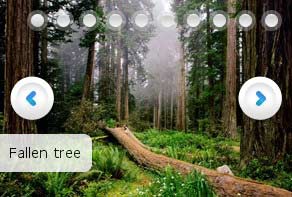http://code.google.com/p/iscroll-js/
http://cubiq.org/iscroll
The
overflow:scroll for mobile webkit. Project started because webkit for
iPhone does not provide a native way to scroll content inside a fixed size
(width/height) div. So basically it was impossible to have a fixed header/footer
and a scrolling central area. Until now.
How to use
First of all we need to prevent the default behavior of standard touch
events. This is easily done adding preventDefault() to the
touchmove event. Then initialize the iScroll object on
DOMContentLoaded or on window load. Here an example:
function loaded() {
document.addEventListener('touchmove', function(e){ e.preventDefault(); });
myScroll = new iScroll('scroller');
}
document.addEventListener('DOMContentLoaded', loaded);
iScroll takes two parameters. The first is mandatory and is the
ID of the element you want to scroll. The second is optional and can be used to
pass additional parameters (see
below).
On the HTML/CSS side the scrolling area needs to be wrapped by an element
which determines the scroller actual size. The following is a common tags
configuration for an iScroll.
<div id="wrapper">
<div id="scroller">
<ul>
<li>...</li>
</ul>
</div>
</div>
The #wrapper also needs some classes:
#wrapper {
position:relative;
z-index:1;
width:/* your desired width, auto and 100% are fine */;
height:/* element height */;
overflow:/* hidden|auto|scroll */;
}
That’s it. Enjoy your scrolling. Have a look at the source code of the online
example to get a better idea of how the iScroll works.
The iScroll syntax is: iScroll(mixed element_id,
object options).
element_id, can be both an object pointing to or a string
with the ID name of the element to be scrolled. Example:
iScroll(document.getElementsByTagName('div')[1]) or
iScroll('scroller')
Accepted options are:
- hScrollbar: set to
false to never show the
horizontal scrollbar. The default value true makes the iScroll
smartly decide when the scrollbar is needed. Note that if device does not
support translate3d hScrollbar is set to false by
default.
- vScrollbar: set to
false to never show the
vertical bar. The default value true makes the iScroll smartly
decide when the scrollbar is needed. Note that if device does not support
translate3d vScrollbar is set to false by default.
- bounce: set to
false to prevent the scroller
to bounce outside of boundaries (Android behavior). Default true
(iPhone behavior).
- bounceLock:, if set to
true the scroller stops
bouncing if the content is smaller than the visible area. Default:
false (as per native iphone scroll).
- checkDOMChanges: set to
false to prevent auto
refresh on DOM changes. If you switch off this feature you have to call
iScroll.refresh() function programmatically every time the DOM gets
modified. If your code makes many subsequent DOM modifications it is suggested
to set checkDOMChanges to false and to refresh the iScroll
only once (ie: when all changes have been done). Default true.
- fadeScrollbar: define wether the scrollbars should fade
in/out. Default
true on iPhone, false on Android. Set
to false for better performance.
- momentum: set to
false to remove the
deceleration effect on swipe. Default true on devices that support
translate3d.
- shrinkScrollbar: set to
false to remove the
shrinking scrollbars when content is dragged over the boundaries. Default
true on iPhone, false on Android. It has no impact on
performances.
- desktopCompatibility: for debug purpose you can set this to
true to have the script behave on desktop webkit (Safari and
Chrome) as it were a touch enabled device.
- snap: set to
true to activate snap scroll.
- scrollbarColor: changes the color of the scrollbar. It
accepts any valid CSS color (default:
'rgba(0,0,0,0.5)'
Note: options must be sent as object not string. Eg:
myScroll = new iScroll(’scroller’, { checkDOMChanges: false, bounce: false, momentum: false });
When calling iScroll with “snap” option the scrolling area is subdivided into
pages and whenever you swipe the scroll position will always snap to the page.
Have a look at the screencast to get an idea.
Probably the best way to use “snap” is by calling it without momentum and
scrollbars:
new iScroll('scroller', { snap:true, momentum:false, hScrollbar:false, vScrollbar:false });
If you keep momentum, you get a free-scrolling that will always stop to
prefixed positions.
To have a perfect snapping experience the scrolling area should be perfectly
divisible by the container size. Eg: If the container width is 200px and you
have 10 elements, the whole scroller should be 2000px wide. This is
not mandatory as iScroll doesn’t break if the last page is
smaller than the container.
Methods
- refresh(): updates all iScroll variables. Useful when the
content of the page doesn’t scroll and just “jumps back”. Call refresh() inside
a zero
setTimeout. Eg: setTimeout(function () {
myScroll.refresh() }, 0).
- scrollTo(x, y, timeout): scrolls to any x,y location inside
the scrolling area.
- scrollToElement(el, runtime): scrolls to any element inside
the scrolling area.
el must be a CSS3 selector. Eg:
scrollToElement("#elementID", '400ms').
- scrollToPage(pageX, pageY, runtime): if snap
option is active, scrolls to any page.
pageX and pageY
can be an integer or prev/next. Two keywords that snap to previous
or next page in the raw. The “carousel” example in the zip file is a
good starting point on using the snap feature.
- destroy(full): completely unloads the iScroll. If called
with
full set to true, the scroller is also removed
from the DOM.
Best practices
DOM Changes – If scrolling doesn’t work after an ajax call
and DOM change, try to initialize iScroll with checkDOMChanges:
false and call refresh() function once the DOM modifications
have been done. If this still doesn’t work try to put refresh() inside a 0ms
setTimeout. Eg:
setTimeout(function () { myScroll.refresh(); }, 0);
Performance – CSS animations are heavy on the small device
CPU. When too many elements are loaded into the scrolling area expect choppy
animation. Try to reduce the number of tags inside the scrolling area to the
minimum. Try to use just ULs for lists and Ps for paragraphs. Remember that you
don’t actually need an anchor to create a button or send an action, so
<li><a href="#" onclick="..."
/>text</a></li> is a waste of tags. You could remove the
anchor and place the click event directly on the LI tag.
Try to avoid box-shadow and CSS gradients (especially on
Android). I know they are cool and classy, but they don’t play well with CSS
animations. Webkit on iPhone seems to handle shadows and gradients a bit better
than its counterpart on Android, so you may selectively add/remove features
based on the device.
Use a flat color for the #wrapper background, images in the scroller wrapper
once again reduce performance.
Important: to preserve resources on devices that don’t
support translate3d (namely: Android<2.0) iScroll disables
momentum, scrollbars and bounce. You can however reactivate them using the
respective options.



